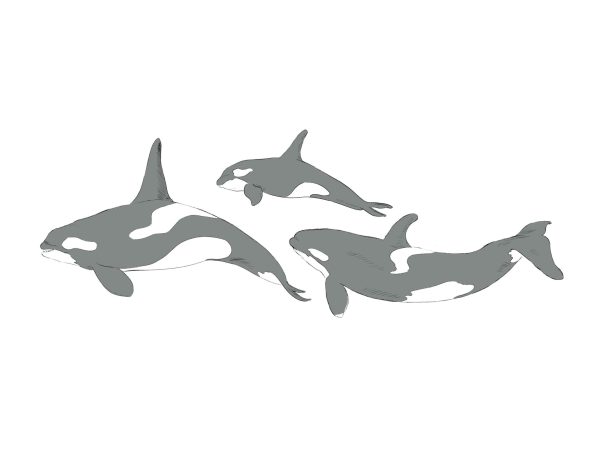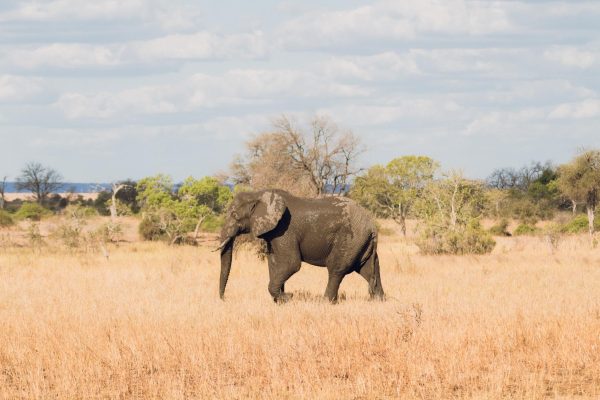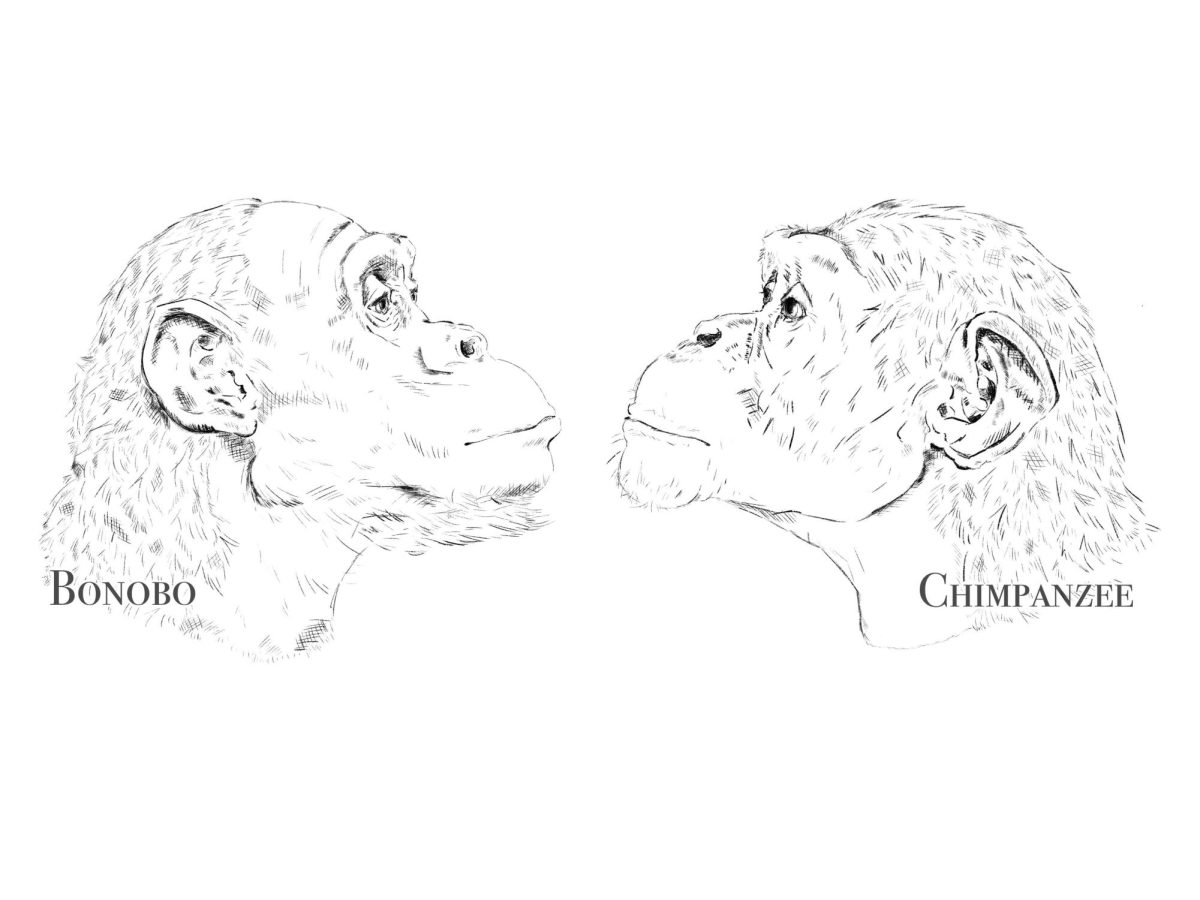What is “natural”?
Social structures organize the framework of our society and are intertwined with the very fabric of our own perception of the world. Currently, the most prominent social structure seen among humans is patriarchy. A common justification for patriarchy as the overarching social structure is that it is “natural” – it is biologically and evolutionarily fated. Somewhere along the way a higher muscle mass and tendency toward aggression were deemed the traits necessary to lead civilizations. However, as science advances and studies examine the plethora of social structures that exist in the wild, it seems patriarchy is not necessarily the norm – in fact some of the most intelligent and our most closely related species exist in matriarchies or egalitarian structures.
Primates: The Long-Lost Relative
Our closest living relatives in the animal kingdom are chimpanzees and bonobos, each with their own unique and complex social structures. Chimpanzees live in extremely hierarchical male dominated social structures. The highest ranking chimpanzee is the alpha male, his rank awarded through grooming and social bonds or aggression and brute strength. Chimps tend to be the more volatile of the two primates with conflict between chimpanzee groups becoming aggressive and oftentimes lethal. Chimpanzees also use tools and cooperatively hunt monkeys as well as sometimes eat the infants of other chimpanzee groups.
Chimpanzees have been known to science since the seventeenth century. This gave time for chimpanzee behavior to be studied and applied to evolutionary biology in the pursuit of understanding human behavior. The war-waging, competition hungry, and male dominated chimpanzee became an excuse for the sometimes violent nature of humans and a so-called explanation for the patriarchy in human society. This picture of human behavior neglects to tell the other crucial half of our evolutionary history.
Bonobos, equally as related to humans as chimpanzees, hold the key to a radically different reality of what constitutes the evolution of human nature. Since chimpanzees were first to be discovered and studied, our perspective was molded based on their social structures. It wasn’t until the 1920s that bonobos were recognized as a separate species from chimpanzees and another 50 years passed before bonobos were studied in the wild.
Bonobos strikingly contrast chimpanzee social structure as their peace-loving, hippie thriving relative. Bonobos organize into a matriarchal, egalitarian leaning, social structure. Females create strong bonds with one another and form coalitions to dominate the males in the group. Male bonobos are still physically stronger than female bonobos, but they do not form male coalitions. For bonobos, sex, same-sex or otherwise, is used in bonding, resolving conflict, greeting, and for comfort. Sex helps bonobos maintain peace as well as avoid infanticide since no one knows who the father of their children is. Though males do sometimes fight, it never reaches the point of lethal aggression. Cooperation and peacekeeping is at the heart of bonobo society.
The structure of bonobos’ brains reflects this higher emotional intelligence possessing more gray matter in areas that composite one’s ability to empathize and socialize. A larger connection between the brain’s amygdala and anterior cingulate cortex also indicates a less aggressive and more emotional take on resolving conflicts. Humans and bonobos share this morphological similarity, but in chimpanzees these specific brain attributes are essentially nonexistent.
Humans have nearly 99% similar genomes to chimpanzees and bonobos, yet each maintains strikingly different social structures. These structures determine the behavior of the group it encases and the characteristics that are valued. The patriarchal society is built on aggression and competition, the matriarchal society on level-headed peacekeeping and empathy. The chimp’s patriarchy elects a single alpha male that dominates all others, whereas the bonobo matriarchy verges on egalitarianism with no one female dominant over everyone else, but a dispersal of power among many females that are tightly bonded to one another. By viewing the behavior of our two most closely related living ancestors we see that not one social structure is evolutionarily pre-destined to be our own societal backbone. Patriarchy is not seared and sealed into our genetics.
Menopause as a Clue
Humans distinguish themselves from most other species in their ability to go through menopause. Most species reproduce well into their old age and then pass away without ever having a period of infertility. It is rare for a species to cease reproducing decades before the end of their life and if they do, it has been an evolutionary quandary as to why.
The grandmother hypothesis works to find an explanation for this, concluding that the cessation of a female’s own reproductive capabilities saves her energy and allows older women in the community to redirect their efforts towards helping their offspring raise children. This evolutionary adaptation increases the survival of their (grand)offspring and thereby their own inclusive fitness and selection by ensuring the continuation of their genes.
The only other species that are known to go through menopause include; orcas, short-finned pilot whales, beluga whales, and narwhals. Studies on orcas in particular have observed the oldest female leading the pod in this matriarchal structure. Learned traits and necessary knowledge for survival is passed through generations of females in a beautiful orchestra of intelligent learning and advancement. Orcas in different pods even show different traditions and learned techniques, developed and taught by the wise grandmothers. Hunting strategies, diet, child rearing, and interaction with humans differ between pods due to the lived experience of female orcas and their grandmothers and so on. Grandmother orcas also provide their babysitting expertise, significantly increasing the survival of calves in the pod with their presence. Wisdom and the leadership of female orcas is exceptionally important, so important that it trumps reproducing. Rather than pass away with the cessation of their ability to reproduce – as might be predicted by traditional evolutionary principles – orcas live on for decades continuing to educate and lead their pods. This behavior increases their inclusive fitness, as is highlighted by the grandmother hypothesis.
Menopause is not a biological failure, instead it is a strategic strength where energy is redirected from reproducing to community-building. It is a biological and evolutionary indicator of the crucial role women play as leaders, mentors, and wisdom-holders. It is nature’s way of telling us that women are important past their childbearing capabilities – they are made to learn and lead and create a major influence on society. Species that have evolved menopause respect their elder grandmothers and see their essential role in leading the group as is reflected by their social structures that lean toward matriarchy and egalitarianism. Orcas and short-finned pilot whales exist in matriarchal structures while beluga whales and narwhals have a more egalitarian social stance. Humans are the only species that go through menopause and exist in a patriarchal social structure.

Matriarchal Wisdom
Even species that do not fully go through menopause, but display traits of the grandmother hypothesis thrive in matriarchies. For example, elephants do not go through menopause, but their reproduction slows near the end of their lives and they play a crucial role in helping their daughters, especially first time mothers, raise their calves. Grandmothers are integral in the survival of their grandchildren and therefore the herd as a whole. The matriarchal structure allows for wisdom to be passed from grandmother to younger generations.
I witnessed this waterfall of knowledge firsthand while living in the South African bush during an internship. When I first arrived, one of the game reserves that would typically be visited was closed due to military activity in the area. The noise and presence of the military often spook wildlife, and when we were finally allowed to return, the animals were noticeably more timid and wary. One elephant in particular, named Te Fiti, had been especially disturbed by human interaction. She began reacting with aggression toward both people and game vehicles.
During a night drive, my colleagues encountered her. Elephants are more easily spooked at night, as their vision is limited in the dark, and Te Fiti was no exception. But instead of flaring her ears in an aggravated mock charge as is to be expected, she responded with aggression and no preceding warning. She charged the game vehicle, attempting to jab her tusks into the grille. The guide slammed the vehicle into reverse and sped backwards down the dirt road. The team returned to camp unscathed, but with a new found fear of elephants.
Te Fiti’s legacy is not through yet though – she has calves, of which she has taught the perils of game vehicles. This learned behavior will likely spread through her herd, becoming part of their defensive repertoire. Though this response is dangerous for humans nearby, it’s remarkable to witness knowledge passed down through generations—a testament to the strength of matriarchal learning and grandmotherly wisdom in elephant society.
Evolutionary Biology vs Patriarchy
As research continues within the realm of evolutionary biology, it becomes clearer to me that patriarchy is not the default for Homo sapiens. Patriarchy in humans has been created in order to benefit the construction of large societies and to benefit the system that wants us to serve it. It puts each person into a convenient box based on their gender and tells them how to live their life and what their role must be. It does not serve women, nor does it serve men. The only benefactor is the system that wants us to be cogs in the machine and forget to tap into our true self. Bonobos demonstrate that our evolutionary past includes a matriarchal structure in which civilization exists without war and violence. Menopause indicates the significance and truly important role that women play in society as leaders and wisdom holders. In the society we exist in today, that means more than just raising children, that means being leaders and visionaries, guiding the next generation. Matriarchies within species that undergo menopause reflect this aspect and the importance of women. These species reflect a less hierarchical structure and the importance of group connection, cooperation, and collaboration. They are emotionally intelligent and lead in such a way that peace is maintained and violence is rarely the mediator. Wisdom is respected and women are the holders. Though we cannot dismantle the patriarchy overnight and instantaneously create a new society, I think there is much to be learned from these ancestors and similarly wired species that we can apply as we consider the future of our societies. An egalitarian society would allow for leaders to guide, artists to create, scientists to discover, and all people to thrive in their own given passions. No forced roles, no mold, no one size fits all. Evolutionary biology refutes the patriarchy, maybe it’s time we do too.

Works Cited
“Bonobos and Chimpanzees.” Ape Initiative, www.apeinitiative.org/bonobos-chimpanzees. Accessed 09 July 2025.
“Bonobos and Chimpanzees: Our Closest Living Relatives.” The Human Journey, 29 Jan. 2025, humanjourney.us/ancestors/our-nearest-relatives-bonobos-and-chimpanzees/bonobos-and-chimpanzees/#:~:text=Chimps%20have%20been%20known%20to,perhaps%2C%20even%20a%20matriarchal%20society? Accessed 09 July 2025.
“Chimps & Bonobos.” Chimp & Bonobos, www.eva.mpg.de/3chimps/files/apes.htm. Accessed 09 July 2025.
Ellis, Samuel, et al. “The Evolution of Menopause in Toothed Whales.” Nature News, Nature Publishing Group, 13 Mar. 2024, www.nature.com/articles/s41586-024-07159-9#Sec7. Accessed 09 July 2025.
Lahdenperä, Mirkka, et al. “Nearby Grandmother Enhances Calf Survival and Reproduction in Asian Elephants.” Nature News, Nature Publishing Group, 10 June 2016, www.nature.com/articles/srep27213. Accessed 09 July 2025.
Lotzof, Kerry. “Killer Whale Behaviour Shows Granny Knows Best.” Natural History Museum, www.nhm.ac.uk/discover/killer-whale-behaviour-shows-granny-knows-best.html. Accessed 09 July 2025.
Mukpo, Ashoka, et al. “Male Dominance Isn’t the Default in Primate Societies, New Study Shows.” Mongabay Environmental News, 4 Mar. 2024, news.mongabay.com/2024/03/male-dominance-isnt-the-default-in-primate-societies-new-study-shows/#:~:text=Among%20the%20great%20apes%2C%20bonobos,non%2Dmale%2Ddominant%20groups. Accessed 09 July 2025.



